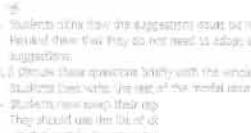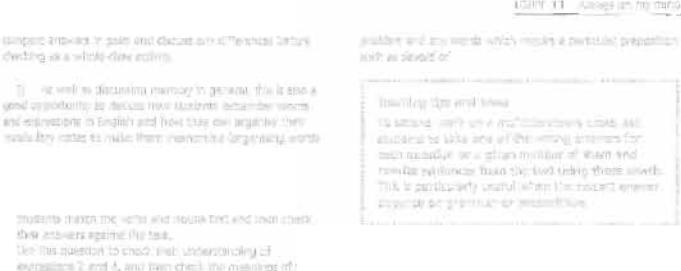
CAE Gold TB
.pdf
UNIT
10 Close to nature
Listening 1 p.116
Aim:
•to practise listening for opinion and attitude
1
Begin by writing the topic environmental issues on the board and asking students what individuals can do to help the environment Ask them to name one thing they already do and one further thing that they could do. Students look at the multiple-choice questions. Play the recording and ask them to decide in pairs after each extract which option is closest to the speaker'sattitude. After this, play it again and highlight any important lexical items like bury your head in the sand.
2Discuss briefly with the class which speaker they agree with.
~Recording script p.l 02
2
Students read and complete the quiz individually and add up their scores. Then they talk in pairs and compare answers.
2Pairs look at the quiz questions again and discuss the first three questions in relation to the issues in each one such as packaging. Discuss the fourth question briefly with the whole class.
3Students work in pairs to write three more questions which they ask and answer in groups. Alternatively, each pair could write just one question and then do a mingling activity where they walk around asking the other pairs their question for a mini classroom survey.
ANSWERS
Grammar 1: countable/uncountable nouns p.117
Aims:
•to revise the grammar of countable and uncountable nouns
•to give practice in completing a gapped sentence exercise
Exam information
In Paper 3, Part 4, there are five sets of three sentences. Students have to think of one word which can be inserted into all three sentences in each group. The word must be exactly the same for all three sentences.
1 Students discuss the sentences in pairs and decide which of the two alternatives is possible or more likely. When checking the answers, point out examples of words which have no countable form such as advice and words which can be used in both forms with a change of meaning such as space.
You might also point out differences here with students'own languages as there are a number of words which are uncountable in English but countable in many other languages like information.
2Students now work in pairs to discuss the words here.
3A switch from countable to uncountable use is one of the ways in which the use of the words in this exercise type may vary between the three sentences. When going through the answers, point out that idea in question 5 provides an example of this .
Ex. 1 |
|
|
|
1 C 2 B |
ANSWERS |
|
|
|
|
||
|
Ex. 1 |
|
|
|
1 |
space 2 Iron 3 |
some advice |
|
4 |
much news 5 a coffee |
|
|
6 |
an amazing time |
7 excellent research |
|
8 |
a hair (hair on the head or body is usually |
|
|
|
uncountable, a single hair (e.g. in food) can be |
|
|
|
countable) |
|
|
9 |
additional information 10 Travel |
|
60

L\IT to Close to nature
Use of English: open doze (Part 2) p.121
Aim:
•for students to complete an exam-style open doze exercise
Teaching tips and ideas
To revise a previously completed cloze exercise, you can use the oral cloze technique. Take the text that students completed in a previous lesson and read it aloud to them blanking out the answers, which they have to remember and supply as a class.
1
Ask students to look at the photo of the police dog. Draw their attention to the difference in salaries and length of career. Then ask the class to suggest answers to questions 1 and 2
2Students skim the text to see if their questions are answered.
2Students now work either in pairs or individually to fill the gaps. Remind them of the suggested procedure on page 112 .
3Students complete the vocabulary exercise individually or in pairs. This could be followed up by a discussion (with the w hole class or in pairs) on issues relating to the use and training of animals (e.g. Do you think it right to train animals like this, Do you think Keela enjoys her work, What else might Keela be useful for i)
ANSWERS |
|
|
|
|
|
|
1 |
being |
2 |
put/placed |
3 |
such |
4 up 5 only |
6 |
what 7 |
is |
8 how |
9 whose |
10 as |
|
11 |
where |
12 get/become |
13 in |
14 This |
||
15 |
which |
|
|
|
|
|
Ex. 3
1an asset
2to have the perfect temperament
3pinpoint
4unique talents
5much in demand
Grammar,2: Introductory It p.122
Aim:
•to raise students'awareness of the use of it as a preparatory subject and object
1
Look at the example with students and establish that the use of the it gives added emphasis to the heavy rain. Ask students to try saying the second sentence with the correct stress and intonation . Then th ey look at the pairs of sentences a and b, underlining the emphasised information.
2Check the answers to these questions with the whole class.
2 Students work in pairs to transform the five sentences. Check the answers by asking individual students to read them out with natural stress and intonation .
Watch Out!
This question is particularly relevant to students who speak pro-drop languages such as Spanish or Italian
3Ask students to look at the example sentences and tell you w hat the object of the verb find is in the second. Point out that the clause in italics is the real object but it also functions as a preparatory object Students then work in pairs to insert the preparatory it in sentences 1 to 7.
4Students will already be familiar with these structures. They work pairs to transform them. Draw attention to the collocation common knowledge.
5Students again work in pairs to correct some of these sentences. When going over the answers, check that they understand that owe in sentence 7 does not refer to money but simply means that we deserve honesty.
6Thi s exercise personalises the grammar of this section. You might wish to delimit it by telling students that all sentences must be about the natural world. You may need to preteach the meaning of the phrase I take it that.
ANSWERS
Ex. 1
1
a) John, not James b) Saturday, not Sunday 2 a) how important pets are b) what some
people will do
3a) to be aware of environmental issues
b) to find environmental issues on the front page
of newspapers
2 |
|
|
|
|
1: 3 |
2: |
2 |
3: |
1 |
62


[ ':-iIT 10 Close to nature
ANSWERS
Ex. 1
1
1 the man 2 the woman
3intonation, vocabulary
4Lack of interest has a negative effect on the listener, and doesn'tcontribute to turn-taking, Sounding involved encourages the listener and creates a positive impression.
2
it is a good idea to ask them for their opinion; it is important to answer using more than one or two words; intonation is important to give a good impression
Ex. 2
Engaging: That'sreally interesting - tell me more; No, I don'treally agree - but what I think is ...; I totally agree - and what'smore ...; A good point - it'sabsolutely true that ...
Offputting: Do you think so?; I suppose so.
ANSWERS
Ex. 1
1
1 keep, catch, made
2cut, calm, narrowed
3tidy, freshening, do
4speak, speeds, livening
5closed, track, settle, die
A2 83 C5 D1 E4
Ex. 2
1 |
down 2 down 3 up 4 up 5 up 6 up |
7 |
up 8 down |
Ex. |
3 |
2,3 |
|
Ex. |
4 |
1 |
breakdown |
2 upset |
3 feedback |
4 clearout |
5 |
takeaway |
6 setback |
7 lineup |
8 turndown |
9 |
outcome |
10 outlook |
|
|
Vocabulary: phrasal verbs and compound nouns p.124
Aims:
•to introduce some phrasal verbs and compound nouns with the particles up and down
•to focus on the meanings associated with these particles
1
1Students insert the correct verbs into the gaps and then compare answers in pairs.
2As a class, they decide which of the meanings describes the use of that particle in each text.
2Students now work in pairs to fill in the correct prepositions. For any expressions which are new, encourage them to try to work out the correct particle by referring to the meanings in 1.2.
3Complete this as a whole-class activity.
4Students work individually or in pairs to form the correct compound for each sentence. Tell them that sometimes the particle comes before and sometimes after the verb, or may do both with a change of meaning as in set up and upset. When checking the answers, point out the use of hyphens for some compounds.
Writing: report (Part 1) p.12S
Aim:
•to practise writing a report
1Students read the task and suggest which of the recommendations here are similar and might be grouped together in the report.
2Remind students briefly of the layout of a report and the usual use of subheadings and bullet points. Then they look at the three plans and tell you which reflects the usual structure of a report.
3Ask students to complete the advice individually by inserting do or don't and then to compare their ideas in pairs. Draw attention to the difference between 5 and 11; they should use all of the given information but avoid copying the same words.
4
1Students skim the report ignoring the gaps and identify which of the plans in Exercise 2 the writer has followed. Then they work in pairs or individually to insert linking words.
2Establish that the input information has been organised into groups, and ask the class to tell you what these groups are and to identify the sentence in the survey results which makes this clear. (Suggestions were divided into recommendations for the day, and ideas that would have an effect in the long-term.) Point out that this type of 'organising'sentence comes before the ideas themselves.
64





